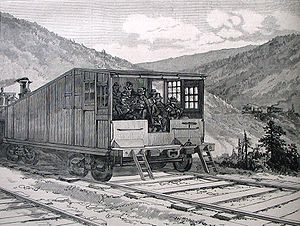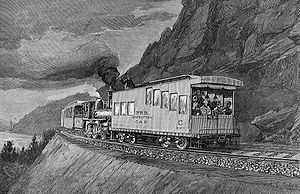
Rail inspection
Encyclopedia

Rail tracks
The track on a railway or railroad, also known as the permanent way, is the structure consisting of the rails, fasteners, sleepers and ballast , plus the underlying subgrade...
for flaws that could lead to catastrophic failures. According to the United States
United States
The United States of America is a federal constitutional republic comprising fifty states and a federal district...
Federal Railroad Administration
Federal Railroad Administration
The Federal Railroad Administration is an agency in the United States Department of Transportation. The agency was created by the Department of Transportation Act of 1966...
Office of Safety Analysis, track defects are the second leading cause of accidents on railways in the United States. The leading cause of railway accidents is attributed to human error. The contribution of poor management decisions to rail accidents caused by infrequent or inadequate rail inspection is significant but not reported by the FRA, only the NTSB. Every year, North American railroads spend millions of dollars to inspect the rails for internal and external flaws. Nondestructive testing
Nondestructive testing
Nondestructive testing or Non-destructive testing is a wide group of analysis techniques used in science and industry to evaluate the properties of a material, component or system without causing damage....
(NDT) methods are used as a preventative measures against track failures and possible derailment.
History

Manchester, New York
Manchester, New York is both a town and a village located in Ontario County, New York.*Manchester , New York*Manchester , New York...
, in 1911. That particular accident resulted in the death of 29 people and injuries to 60 others. The investigation of the accident revealed that the cause was a transverse fissure (a critical crack which lies perpendicular to the length of the rail) in the rail. Further investigation in the late 1920s showed that this type of defect was quite common. With increased rail traffic at higher speeds and with heavier axle loads today, critical crack sizes are shrinking and rail inspection is becoming more important. In 1927, Dr. Elmer Sperry built a massive rail inspection car
Sperry Rail Service
Sperry Rail Service is a company contracted by most of the major railroads in North America to inspect rail.The rail flaw detector car was invented by Dr. Elmer A. Sperry...
under contract with the American Railway Association
American Railway Association
The American Railway Association was an industry trade group representing railroads in the United States. The organization had its inception in meetings of General Managers and ranking railroad operating officials known as Time Table Conventions, the first of which was held on October 1, 1872, at...
. Magnetic induction
Magnetic induction
Magnetic induction may refer to one of the following:* Electromagnetic induction* Magnetic field B is sometimes called magnetic induction...
was the method used on the first rail inspection cars. This was done by passing large amounts of magnetic field through the rail and detecting flux
Flux
In the various subfields of physics, there exist two common usages of the term flux, both with rigorous mathematical frameworks.* In the study of transport phenomena , flux is defined as flow per unit area, where flow is the movement of some quantity per time...
leakage with search coils. Since then, many other inspection cars have traversed the rails in search of flaws.
Defects and location
There are many effects that influence rail defects and rail failure. These effects include bending and shear stresses, wheel/rail contact stresses, thermal stresses, residual stresses and dynamic effects.Defects due to contact stresses or rolling contact fatigue (RCF):
- tongue lipping
- head checking (gauge corner cracking)
- squats - which start as small surface breaking cracks
Other forms of surface and internal defects:
- corrosionCorrosionCorrosion is the disintegration of an engineered material into its constituent atoms due to chemical reactions with its surroundings. In the most common use of the word, this means electrochemical oxidation of metals in reaction with an oxidant such as oxygen...
- inclusions
- seams
- shelling
- transverse fisures
- wheel burn
One effect that can cause crack propagation is the presence of water and other liquids. When a fluid fills a small crack and a train passes over, the water becomes trapped in the void and can expand the crack tip. Also, the trapped fluid could freeze and expand or initiate the corrosion process.
Parts of a rail where defects can be found:
- head
- web
- foot
- switchblades
- welds
- bolt holes
A majority of the flaws found in rails are located in the head, however, flaws are also found in the web and foot. This means that the entire rail needs to be inspected.
NDT methods
A list of methods used to detect flaws in rails:- UltrasoundUltrasoundUltrasound is cyclic sound pressure with a frequency greater than the upper limit of human hearing. Ultrasound is thus not separated from "normal" sound based on differences in physical properties, only the fact that humans cannot hear it. Although this limit varies from person to person, it is...
- the most popular method - Eddy currentEddy currentEddy currents are electric currents induced in conductors when a conductor is exposed to a changing magnetic field; due to relative motion of the field source and conductor or due to variations of the field with time. This can cause a circulating flow of electrons, or current, within the body of...
inspection - great for surface flaws & near surface flaws - Magnetic Particle Inspection (MPI) - used for detailed manual inspection
- RadiographyRadiographyRadiography is the use of X-rays to view a non-uniformly composed material such as the human body. By using the physical properties of the ray an image can be developed which displays areas of different density and composition....
- used on specific locations (often predetermined) such as bolt holes and where thermite welding was used - Magnetic inductionMagnetic inductionMagnetic induction may refer to one of the following:* Electromagnetic induction* Magnetic field B is sometimes called magnetic induction...
or Magnetic flux leakageMagnetic flux leakageMagnetic flux leakage is a magnetic method of nondestructive testing that is used to detect corrosion and pitting in steel structures, most commonly pipelines and storage tanks. The basic principle is that a powerful magnet is used to magnetize the steel. At areas where there is corrosion or...
- earliest method used to locate unseen flaws in the railway industry - EMAT Electromagnetic Acoustic Transducer
Utilizing NDT methods
The techniques mentioned above are utilized in a handful of different ways. The probes and transducers can be utilized on a “walking stick”, on a hand pushed trolleyRail push trolley
A railway push trolley or simply a push-trolley is a hand-pushed trolley used to inspect the rails and other track-side railway infrastructure. It is a simple trolley, pushed by two or four persons , with hand brakes to stop the trolley. When the trolley slows down, two trolleymen jump off the...
, or in a hand held setup. These devices are used when small sections of track are to be inspected or when a precise location is desired. Many times these detail oriented inspection devices follow up on indications made by a rail inspection cars or HiRail trucks. Handheld inspection devices are very useful for this when the track is used heavily, because they can be removed relatively easy. However, they are considered very slow and tedious, when there are thousands of miles of track that need inspection.
Rail inspection cars and HiRail trucks are the answer to today’s high mileage inspection needs. The first rail inspection cars were created by Dr. Sperry. Since then, many new models have rolled out. These rail inspection cars are basically their own train with inspection equipment on board. The probes and transducers are mounted on carriages located underneath the inspection car. Modern day inspection cars now use multiple NDT methods. Induction and ultrasound methods can be used in rail inspection cars and operate at testing speeds of more than 30 mph (13.4 m/s). The next generation will go even faster.
There are many manufacturers of road/rail inspection trucks, otherwise known as HiRail trucks. These HiRail inspection cars are almost all ultrasonic testing exclusively, but there are some with the capability to perform multiple tests. These trucks are loaded with high speed computers using advanced programs which recognize patterns and contain classification information. The trucks are also equipped with storage space, tool cabinets, and workbenches. A GPS
Global Positioning System
The Global Positioning System is a space-based global navigation satellite system that provides location and time information in all weather, anywhere on or near the Earth, where there is an unobstructed line of sight to four or more GPS satellites...
unit is used with the computer to mark new defects and locate previously marked defects. The Federal Railroad Administration
Federal Railroad Administration
The Federal Railroad Administration is an agency in the United States Department of Transportation. The agency was created by the Department of Transportation Act of 1966...
(FRA) requires that any indications of defects need to be hand verified immediately. The GPS system allows a follow up car to find precisely where the flaw was detected by the lead vehicle. One advantage to the HiRail trucks is that they can work around regular rail traffic without shutting down or slowing down entire stretches of track. However, because railroad management frequently orders HiRail trucks to be used to inspect tracks at speeds over 50 mph (22.4 m/s), tracks reported as having been inspected are, in fact, not inspected. A NTSB report on the Amtrak derailment in Oregon in 2006 documented this fact.
The future of rail inspection
With increased rail traffic carrying heavier loads at higher speeds, a quicker more efficient way of inspecting railways is needed. Lasers inspect railway geometry, but one day they might be utilized as a form of non-contact evaluation of the rail. This most likely will be done with laser-optical transmitting transducers in ultrasonic testing. Eliminating contact with the rail could one day allow high speed detection of flaws. Another need for the future is a complete rail inspection system. A step in this direction is deeper investigation of the rail by using low frequency eddy currents. Other advancements could include neural network analysis of signals to improve defect detection and identification and longitudinal guided ultrasonics. Improved rail quality, composition, and joining techniques could lead to better wear characteristics and a longer lifespan of the rail. Some investigation into banitic steels looks promising. A safe and portable means of filmless radiography could assist with onsite defect evaluation. These are just a few advancements in the process of being developed for future use.See also
- Maintenance of way
- Nondestructive testingNondestructive testingNondestructive testing or Non-destructive testing is a wide group of analysis techniques used in science and industry to evaluate the properties of a material, component or system without causing damage....
- Rail tracks
- Work trainWork trainWork train refers to any of a number of rail cars intended for internal non-revenue use by the railroad's operator. Work trains serve functions such as track maintenance, maintenance of way, revenue collection, system cleanup and waste removal, heavy duty hauling, and crew member transport.- Types...
- Track checkerTrack checkerA track checker is a small railway carriage used in the United States and Ireland to audit the gauge and integrity of railway tracks. The first track checkers were simply people that walked the tracks, making sure that the tracks were not damaged and that the switches were working. These people...

